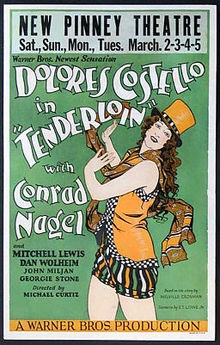
The Singing Fool is a 1928 American sound part-talkie musical drama motion picture directed by Lloyd Bacon which was released by Warner Bros. In addition to sequences with audible dialogue or talking sequences, the film features a synchronized musical score and sound effects along with English intertitles. The soundtrack was recorded using the Vitaphone sound-on-disc system. The film stars Al Jolson and is a follow-up to his previous film, The Jazz Singer. It is credited with helping to cement the popularity of American films of both sound and the musical genre. The film entered the public domain on January 1, 2024.

Glorious Betsy is a 1928 sound part-talkie drama film. In addition to sequences with audible dialogue or talking sequences, the film features a synchronized musical score and sound effects along with English intertitles. The soundtrack was recorded using the Vitaphone sound-on-disc system. The film is based on the 1908 play of the same name by Rida Johnson Young, and it stars Dolores Costello. It was produced by Warner Bros. and nominated for an Academy Award for Best Writing, Adaptation in 1929. The film was directed by Alan Crosland with cinematography by Hal Mohr.
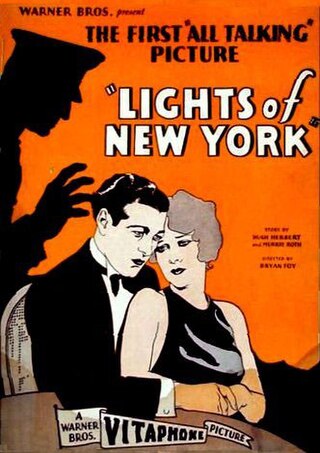
Lights of New York is a 1928 American crime drama film starring Helene Costello, Cullen Landis, Wheeler Oakman and Eugene Pallette, and directed by Bryan Foy. Filmed in the Vitaphone sound-on-disc sound system, it is the first all-talking full-length feature film, released by Warner Bros., who had introduced the first feature-length film with synchronized sound Don Juan, in 1926; and the first with spoken dialogue, The Jazz Singer, in 1927. The film, which cost $23,000 to produce, grossed over $1 million. The enthusiasm with which audiences greeted the talkies was so great that by the end of 1929, Hollywood was producing sound films exclusively.
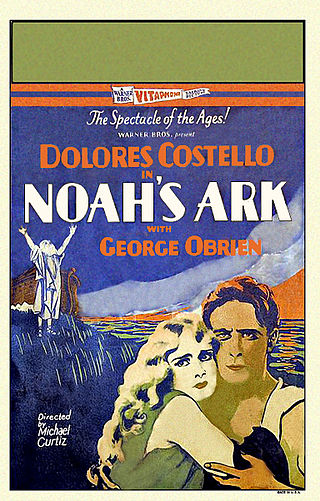
Noah's Ark is a 1928 American part-talkie epic disaster film directed by Michael Curtiz and starring Dolores Costello and George O'Brien. In addition to sequences with audible dialogue or talking sequences, the film features a synchronized musical score and sound effects along with English intertitles. The soundtrack was recorded using the Vitaphone sound-on-disc system. The story is by Darryl F. Zanuck. The film was released by the Warner Bros. studio. Most scenes are silent with a synchronized music score and sound effects, in particular the biblical ones, while some scenes have dialogue.

While London Sleeps is a 1926 synchronized sound Warner Bros. film about a police-dog, Rinty, who helps Scotland Yard defeat a dangerous criminal organisation known as the Mediterranean Brotherhood that operates out of the Limehouse district of London. While the film has no audible dialog, it was released with a synchronized musical score with sound effects using both the Vitaphone sound-on-disc process. Walter Morosco wrote the screenplay. It was the first of many films directed by Howard Bretherton, and one of several created for Rin Tin Tin, a German Shepherd dog used in films during the 1920s and 1930s. Only the sound discs to the film survive today with the visual film portions being lost. The British release prints censored the more horrific aspects of the film.

My Man is a 1928 black and white sound part-talkie American comedy-drama musical film directed by Archie Mayo starring Fanny Brice and featuring Guinn "Big Boy" Williams. In addition to sequences with audible dialogue or talking sequences, the film features a synchronized musical score and sound effects along with English intertitles. The soundtrack was recorded using the Vitaphone sound-on-disc system.
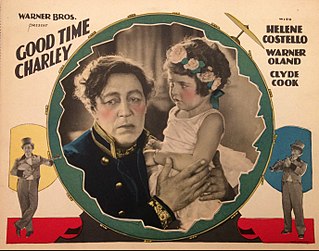
Good Time Charley is a 1927 American synchronized sound drama film produced and distributed by Warner Bros. and directed by Michael Curtiz. While the film has no audible dialog, it was released with a synchronized musical score with sound effects using the Vitaphone sound-on-disc process. It was considered to be a lost film. However, as of January 2021, the film is listed as extant at the Library of Congress.
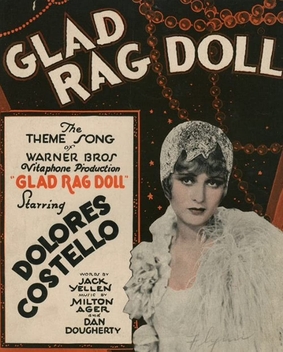
Glad Rag Doll is a 1929 American sound part-talkie pre-Code drama film directed by Michael Curtiz, and starring Dolores Costello, Ralph Graves, and Audrey Ferris. In addition to sequences with audible dialogue or talking sequences, the film features a synchronized musical score and sound effects, along with English intertitles. The soundtrack was recorded using the Vitaphone sound-on-disc system. This is one of many lost films of the 1920s, no prints or Vitaphone discs survive, but the trailer survives. The film's working title was Alimony Annie, but was changed match the title of the theme song. The theme song is entitled Glad Rag Doll both played and sung throughout the soundtrack.

Hearts in Exile is a 1929 American pre-Code romance film produced and distributed by Warner Bros. and directed by Michael Curtiz. It was also released in a silent version with music and effects. It starred Dolores Costello in a story based on the 1904 novel by John Oxenham. An earlier 1915 film starring Clara Kimball Young was also produced, and is extant, but the 1929 version is considered to be a lost film.

Old San Francisco is a 1927 American synchronized sound historical drama film starring Dolores Costello and featuring Warner Oland. While the film has no audible dialog, it was released with a synchronized musical score with sound effects using the Vitaphone sound-on-disc process. The film, which was produced and distributed by Warner Bros., was directed by Alan Crosland.

When a Man Loves is a 1927 American synchronized sound historical drama film directed by Alan Crosland and produced and distributed by Warner Bros. While the film has no audible dialog, it was released with a synchronized musical score with sound effects using the Vitaphone sound-on-disc process. The picture stars John Barrymore and features Dolores Costello in the frequently filmed story of Abbe Prevost's 1731 novel Manon Lescaut. The lovers suffer, but the film has an optimistic ending, as they head to America. Manon dies at the end of the novel. The UK release title was His Lady.

The Midnight Taxi is a 1928 American early sound part-talkie thriller picture from Warner Bros. directed by John G. Adolfi and starring Antonio Moreno, Helen Costello, and Myrna Loy. In addition to sequences with audible dialogue or talking sequences, the film features a synchronized musical score and sound effects along with English intertitles. The soundtrack was recorded using the Vitaphone sound-on-disc system.

The Terror is a 1928 American pre-Code horror film written by Harvey Gates and directed by Roy Del Ruth, based on the 1927 play of the same name by Edgar Wallace. It was the second "all-talking" motion picture released by Warner Bros., following Lights of New York. It was also the first all-talking horror film, made using the Vitaphone sound-on-disc system.

The Redeeming Sin is a 1929 crime drama sound part-talkie film. In addition to sequences with audible dialogue or talking sequences, the film features a synchronized musical score and sound effects along with English intertitles. The soundtrack was recorded using the Vitaphone sound-on-disc system. It was produced and distributed by Warner Bros. and stars Dolores Costello. This film is a lost film.
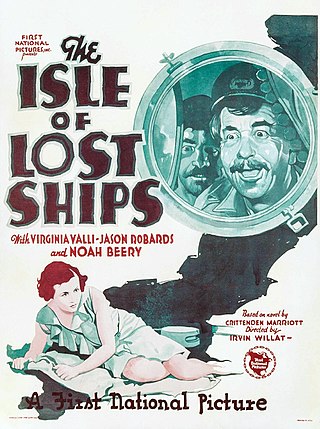
The Isle of Lost Ships is an all-talking 1929 sound film. The picture was produced by Richard A. Rowland and distributed by Warner Bros. Irvin Willat was the director with Jason Robards Sr., Virginia Valli and Noah Beery Sr. in the leads. It is based on the 1909 novel The Isle of Dead Ships by Crittenden Marriott, and is also a remake of Maurice Tourneur's now lost 1923 classic of the same name. A mute copy of this film is preserved at the Library of Congress. The Vitaphone discs which contain the soundtrack to the film are currently lost.

The Better 'Ole is a 1926 American synchronized sound World War I comedy drama film. Released by Warner Bros. Pictures, Inc., this film is the second full-length film to utilize the Vitaphone sound-on-disc process, two months after the first Vitaphone feature Don Juan; with no audible dialogue, the film does have a synchronized musical score and sound effects. This film was also the second onscreen adaptation of the 1917 musical The Better 'Ole by Bruce Bairnsfather and Arthur Elliot. Charlie Chaplin's eldest brother Sydney Chaplin played the main lead as Old Bill in perhaps his best-known film today. This film is also believed by many to have the first spoken word of dialog, "coffee", although there are those who disagree. At one point during the film, Harold Goodwin's character whispers a word to Sydney Chaplin which is also faintly heard. This was discovered by the UCLA's Robert Gitt, during the restoration of the sound discs for the film. The line was recorded in perfect sync, apparently during the orchestra recording sessions rather than live on set, therefore making it the earliest known use of dubbing in a motion picture.
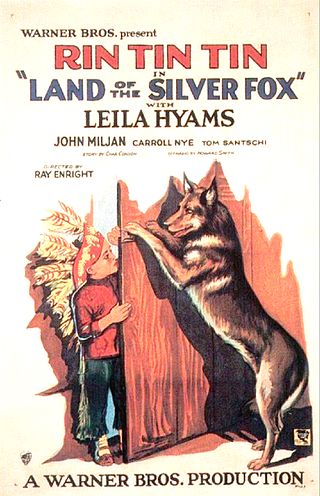
Land of the Silver Fox is a 1928 sound part-talkie American adventure film directed by Ray Enright and written by Howard Smith and Joseph Jackson. In addition to sequences with audible dialogue or talking sequences, the film features a synchronized musical score and sound effects along with English intertitles. The soundtrack was recorded using the Vitaphone sound-on-disc system. The film stars Rin Tin Tin, Leila Hyams, John Miljan, Carroll Nye, Tom Santschi, and Neola May. The film was released by Warner Bros. on October 18, 1928.
Caught in the Fog is a 1928 American sound part-talkie thriller film directed by Howard Bretherton and written by Charles R. Condon and Joseph Jackson. In addition to sequences with audible dialogue or talking sequences, the film features a synchronized musical score and sound effects along with English intertitles. The soundtrack was recorded using the Vitaphone sound-on-disc system. The film stars May McAvoy, Conrad Nagel and Mack Swain, and features Hugh Herbert, Charles K. Gerrard and Émile Chautard. The film was released by Warner Bros. on August 25, 1928.
Kid Gloves is a 1929 American sound part-talkie pre-Code drama film directed by Ray Enright, and starring Conrad Nagel, Lois Wilson, Edward Earle, Edna Murphy, and Maude Turner Gordon. In addition to sequences with audible dialogue or talking sequences, the film features a synchronized musical score and sound effects along with English intertitles. The soundtrack was recorded using the Vitaphone sound-on-disc system. The film was released by Warner Bros. on March 23, 1929.

Husbands for Rent is a 1927 American synchronized sound comedy film directed by Henry Lehrman and written by C. Graham Baker, Joseph Jackson and Jimmy Starr. While the film has no audible dialog, it was released with a synchronized musical score with sound effects using the Vitaphone sound-on-disc process. The film stars Owen Moore, Helene Costello, Katherine Perry, John Miljan, Claude Gillingwater and Arthur Hoyt. The film was released by Warner Bros. on December 31, 1927.
